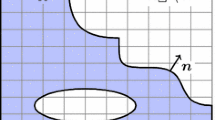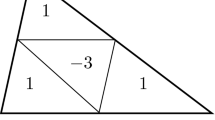Abstract
The finite element code Kaskade has been developed for the solution of partial differential equations in one, two, and three space dimensions. Its object-oriented implementation concept is based on the programming language C++. Adaptive finite element techniques are employed to provide solution procedures of optimal computational complexity. This implies a posteriori error estimation, local mesh refinement and multilevel preconditioning.
One major concept of the implementation is the separation of ‘geometric’ and ‘algebraic’ entities. The former ones mainly comprise typical problem-dependent classes like the mesh, the finite element, and the materials. The mesh structure and node distribution may be rather complex due to the nested refinement levels created in the adaptive solution process. By using a global node-numbering strategy we transfer the geometry-based features into algebraic structures; the latter include special sparse matrix classes and vector templates.
Beyond the formal description of the code we present an application arising in a current research project. Here a real-life problem has to be solved, involving the calculation of electromagnetic fields and temperature distributions in human bodies in order to support hyperthermia treatment planning in a clinical environment.
Access this chapter
Tax calculation will be finalised at checkout
Purchases are for personal use only
Preview
Unable to display preview. Download preview PDF.
Similar content being viewed by others
References
I. Babušhka, O. C. Zienkiewicz, J. Gago and E. R. A. de Oliveira, editors. Accuracy Estimates and Adaptive Refinements in Finite Element Computations. Wiley, 1986.
R. E. Bank. PLTMG 7.0 — A Software Package for Solving Elliptic Partial Differential Equations. Users’ Guide 7.0, SIAM, 1994.
R. E. Bank, T. Dupont and H. Yserentant. The hierarchical basis multigrid method. Numer. Math., 52, pp. 427–458, 1988.
R. E. Bank, A. Sherman and A. Weiser. Refinement algorithms and data structures for local mesh refinement. In R. Stepleman et al., editor, Scientific Computing. IMACS/North Holland, Amsterdam, 1983.
R. Barret, M. Berry, T. Chan, J. Demmel, J. Donato, J. Dongarra, V. Eijkhout, R. Pozo, C. Romine and H. van der Vorst. Templates for the Solution of Linear Systems: Building Blocks for Iterative Methods. SIAM, 1993.
P. Bastian, K. Birken, K. Johannsen, S. Lang, N. Neuss, H. Rentz-Reichert and C. Wieners. UG — a flexible software toolbox for solving partial differential equations. Technical report, Institut für Computeranwendungen III, Universität Stuttgart, 1996.
A. Bayliss, M. Gunzburger and E. Turkel. Boundary conditions for the numerical solution of elliptic equations in exterior regions. SIAM J. Appl. Math., 42, pp. 430–451, 1982.
R. Beck, H. C. Hege, M. Seebass, P. Wust, P. Deuflhard and R. Felix. Adaptive finite element codes for numerical calculations in hyperthermia treatment planning. In C. Franconi, G. Arcangeli and R. Cavaliere, editors, Proc. of the 7th Int. Congress on Hyperthermic Oncology, Rome,Italy, 1996.
J. Bey. Tetrahedral grid refinement. Computing, 55, pp. 355–378, 1995.
F. Bornemann. An adaptive multilevel approach to parabolic equations I. Impact of Comput. Sci. Engrg., 4, pp. 1–45, 1992.
A. Bossavit. Whitney forms: a class of finite elements for three-dimensional computation in electromagnetism. Inst. Elec. Eng. Proc., Part A, 135, pp. 493–500(8), 1988.
J. H. Bramble, J. E. Pasciak and J. Xhu. Parallel multilevel preconditioners. Math. Corp., 55, pp. 1–22, 1990.
S. C. Brenner and L. R. Scott. The Mathematical Theory of Finite Element Methods. Texts in Applied Mathematics, Vol. 15, Springer, 1994.
A. M. Bruaset, E. Holm and H. P. Langtangen. Increasing the efficiency and reliability of software development for systems of PDEs. In E. Arge, A. M. Bruaset and H. P. Langtangen, editors, Modern Software Tools for Scientific Computing, pages 247–268. Birkhäuser, 1997.
P. Deuflhard, P. Leinen and H. Yserentant. Concepts of an adaptive hierarchical finite element code. Impact of Comput. Sci. Engrg., 1, pp. 3–35, 1989.
I. S. Duff. MA28 — A Set of FORTRAN Subroutines for Sparse Unsymmetric Linear Equations. Technical report, AERE—R.8730, Harwell, 1980.
B. Erdmann, J. Lang and R. Roitzsch. KASKADE Manual Version 2.0: FEM for 2 and 3 Space Dimensions. Technical report, KonradZuse-Zentrum für Informationstechnik Berlin, 1993.
A. George and J. W. -H. Liu. Computer Solution of Large Sparse Positive Definite Systems. Prentice Hall, Englewood Cliffs, New Jersey, 1981.
W. Hackbusch. Multi-Grid Methods and Applications. Springer, Berlin, 1985.
W. Hackbusch. Iterative Solution of Large Sparse Linear Systems of Equations. Springer, Berlin, 1993.
R. H. W. Hoppe and R. Kornhuber. Adaptive multilevel methods for obstacle problems. SIAM J. Numer. Anal, 31(2), pp. 301–323, 1994.
J. Jin. The Finite Element Method in Electrodynamics. John Wiley & Sons, New York, 1993.
V. N. Kannelopoulos and J. P. Webb. A numerical study of vector absorbing boundary conditions for the finite element solution of Maxwell’s equations. IEEE Microwave Guided Wave Lett., 1, pp. 325–327, 1991.
H. Kardestunger and D. H. Norrie, editors. Finite Element Handbook. McGraw-Hill, New York, 1987.
R. Kornhuber. Adaptive Monotone Multigrid Methods for Nonlinear Variational Problems. Wiley-Teubner, 1997.
J. C. Nedelec. Mixed finite elements in R 3 . Numer. Math., 35, pp. 315–341, 1980.
K. D. Paulsen, X. Jia and J. M. Sullivan. Finite element computations of specific absorption rates in anatomically conforming full-body models for hyperthermia treatment analysis. IEEE Trans. Biomed. Engrg., 40(9, pp. 933–945), 1993.
H. H. Pennes. Analysis of tissue and arterial blood temperatures in the resting human forearm. Journal of Applied Physiology, 1, pp. 93–122, 1948.
M. C. Rivara. Design and data structure of a fully adaptive multigrid finite element software. ACM Trans. Math. Software, 10, pp. 242–264, 1984.
R. B. Roemer and A. W. Dutton. A new tissue convective energy balance equation for predicting tissue temperature distributions. Presented at: ICHO VII, Rome, Italy, April 9–13, 1996; University of Utah preprint, Salt Lake City, 1996.
B. Smith, P. Bjørstadt and W. Gropp. Domain Decomposition. Parallel Multilevel methods for Elliptic Partial Differential Equations. Cambridge University Press, Cambridge, 1996.
G. Wittum. On the convergence of multigrid methods with transforming smoothers. Numer. Math, 57, pp. 15–38, 1990.
P. Wust, M. Seebass, J. Nadobny, P. Deuflhard, G. Mönich and R. Felix. Simulation studies promote technological development of radiofrequency phased array hyperthermia. Int. J. Hyperthermia 12, pp. 477–494, 1996.
H. Yserentant. Hierarchical bases give conjugate gradient methods a multigrid speed of convergence. Appl. Math. and Comp. 19, pp. 347–358, 1986.
S. Zhang. Multilevel Iterative Techniques. Ph.D. Thesis, Pennsylvania State University, 1988.
O. C. Zienkiewicz, J. P. S. R. de Gago and D. W. Kelly. The hierarchical concept in finite element analysis. Computers and Structures, 16, pp. 53–65, 1983.
O. C. Zienkiewicz and J. Z. Zhu. The superconvergent patch recovery (SPR) and adptive finite element refinement. Corp. Meth. Appl. Mech. Eng., 101, pp. 207–224, 1992.
Author information
Authors and Affiliations
Editor information
Editors and Affiliations
Rights and permissions
Copyright information
© 1997 Springer Science+Business Media New York
About this chapter
Cite this chapter
Beck, R., Erdmann, B., Roitzsch, R. (1997). An Object-Oriented Adaptive Finite Element Code: Design Issues and Applications in Hyperthermia Treatment Planning. In: Arge, E., Bruaset, A.M., Langtangen, H.P. (eds) Modern Software Tools for Scientific Computing. Birkhäuser, Boston, MA. https://doi.org/10.1007/978-1-4612-1986-6_5
Download citation
DOI: https://doi.org/10.1007/978-1-4612-1986-6_5
Publisher Name: Birkhäuser, Boston, MA
Print ISBN: 978-1-4612-7368-4
Online ISBN: 978-1-4612-1986-6
eBook Packages: Springer Book Archive




